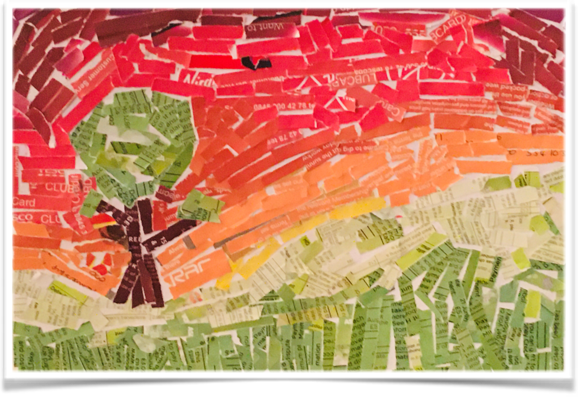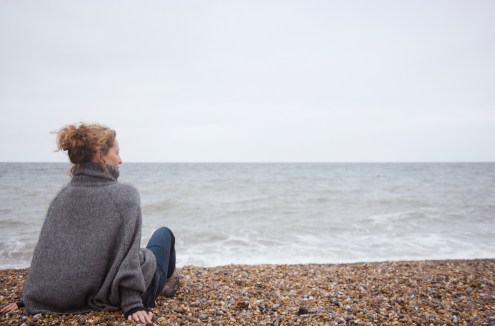Keep it happy – ‘Happy Daze’
In this blog trainee Ollie Coach Deborah Stephenson describes how we create emotional anchors all the time - even when decorating!

This week I have been decorating.
Strange as it may seem, I really enjoy it. I like the fresh thick paint, the swoosh of the roller and the tiny cold wet spatters it leaves on my skin, the shiny white gloss, and the challenge of gliding the brush along the skirting boards to make the edges look neat!
I like that it takes just enough concentration to stop direct thinking, leaving the subconscious to drift in and out with thoughts. I especially like that it’s ok to slap paint all over the wall which ordinarily would be a disaster! I even like that ‘new paint’ smell.
When all the used paint pots, and brushes are cleared, and the dust sheets are lifted, the room is transformed and there is a feeling of having created a new space, but that the old room must still be around somewhere, and of course it is – hidden under the coats of new paint.
This time my daughter helped. It was her bedroom that we were transforming, from the tired “Sorbet” pink of the last eight years to her new choice of bright “Happy Daze” yellow (I’d love to have a job naming paints!).
She smiled wistfully as we rolled a layer of white over the multitude of little oily dots left from sticking and unsticking dozens of drawings, cards, certificates, postcards and pictures, leaving an empty blank box. She enjoyed seeing the streaks of warm yellow that appeared as she pushed the roller, thick with paint, over the walls. Before long, there was just one big white patch left.
“I’d love to draw a sunshine there,” she said.
“Ok” I smiled. “Why not!”
Grinning, she took a wide paintbrush and made a huge sun with a smiling face twice the size of hers, and wrote “Happy” in big letters underneath. We stood back in appreciation.

“It seems a shame to cover it up.” I said sadly.
“Oh it’s ok” she replied, busily coating the roller with more paint, “I’ll always know it is there, and it will make me feel happy when I think about it.” She lifted the roller and lavishly filled the wall with colour.
I love that she has left a secret happy message to herself in her room… a source of reassurance… invisible… waiting to cheer her up one day.
It’s like a form of anchoring.
Anchoring is when we create a positive feeling or emotion in a person, usually with a touch or word (the anchor), that they can then do for themselves when they need to feel that positivity.
To set it up, we can ask the person to think about a time when they felt that emotion – maybe happy, calm, or relaxed. When they are feeling it strongly, we can apply a pre-arranged signal like a double tap on a knuckle, or a squeeze of a finger. It works by connecting and associating neural pathways in the brain – the signal becomes associated with the emotion. If the the feeling is strong enough and the anchor is set well, then the person can trigger it again at moments of stress, anger, or anxiety, to experience that calm, happier feeling.
You probably know the story of Pavlov’s dogs – Pavlov rang a bell when he gave them food. He found that if he rang the bell, the dogs would salivate even if there was no food, because the sound of the bell was connected to the response and triggered it.
This happens to us all the time, not the salivating of course, but listening to a song on the radio and suddenly remembering a long forgotten event, or the smell of a particular suncream triggering a vivid recollection of a beach holiday.
It can be very powerful, which is why it is used in advertising – for example, associating kids in bright white football kits to a particular washing powder, or healthy active dogs with shiny coats to a particular brand of pet food. When we are shopping, the trigger and response system kicks in, and we buy the washing powder because we associate it with the impossibly white t-shirts, and the dog food to make sure our much loved pooch is healthy and happy.
If we are trying to help someone to trigger an emotion in situations they find difficult, then it is useful if it can be done easily and without others seeing (like a squeeze of a fingertip) or, as in the case of the yellow sunshine, it can even be invisible. If my daughter feels worried or sad, she knows the sunshine is there, just below the surface, and hopefully it will trigger a little boost of Happy.
I wonder, with a small pang, when she will next need to think about the invisible yellow sunshine, but I feel strangely reassured it is there for her. I will try to remind her of it too when I think she needs it.
Next time you do some decorating why not sneak in a positive message that only you know is there! You never know when you might just need to look at a wall and smile!!!
And there’s something else too…
All this got me thinking…
Over the years, the things people say to us, how they make us feel, the things we tell ourselves, comments, compliments and criticisms, are all painted on our internal wall – not those that divide our kitchens and living rooms, but the ones inside our mind… layer upon layer of words and images – all invisible to others, hidden under the veneer of our outer selves.
What’s on yours?
Just as in an old house where the walls have been painted many times, each layer will tell a different story. They are all there, the happy sunshines, black clouds, bright achievements, and dark swirls of stress or sorrow.
Maybe it’s time for a refresh? Time to take a big thick brush – and any wonderfully named colour you make up – and slap on the paint. Paint thickly over troublesome thoughts and create positive new ones that you that can draw on in tough times. The beauty is, you don’t even have to go to a DIY store or clear up afterwards!
Enjoy the transformation, but remember the compliments when you feel unsure, endorsements when you are nervous, and cheerful comments when you feel sad. They are all still there, in layers under the surface.
Choose what to remember and when to use them, and choose wisely.
Deborah Stephenson, Ollie Coach trainee
I am an Ollie School trainee and a Director at an Independent Prep School for boys. I am a trained journalist and worked in BBC Local Radio for more than twenty years as a reporter, bulletin reader, news editor and programme maker. It was a great job, but I wanted to do something to support my own children’s wellbeing with a view to taking that on to support others and, in pursuit of a better work life balance, I resigned as the Assistant Editor of BBC Essex last year. Inspired by the Ollie School concept I was excited to be accepted for the training course and it has been a fascinating and enlightening and journey so far.
To get in contact with Deborah, email info@ollieandhissuperpowers.com
To find out more about Ollie and his Super Powers and how to become an Ollie Coach go to https://www.ollieandhissuperpowers.com/pages/about-us
Caroline Chipper
Director
Co founder of Subconquest Ltd, that trades as Ollie and his Super Powers. My many years of commercial experience is being put to good use managing the business side of Ollie, including working with our Ollie Coaches, and managing our contracts. In everything we do its about making a difference to those we work with. To find out more go to https://www.ollieandhissuperpowers.com/pages/about-us


